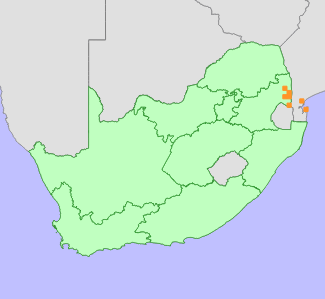|
Scientific Name | Aloe komatiensis Reynolds |
Higher Classification | Monocotyledons |
Family | ASPHODELACEAE |
Synonyms | Aloe decurvidens Groenew., Aloe lusitanica Groenew. |
National Status |
Status and Criteria | Vulnerable B1ab(i,ii,iii,iv,v)+2ab(i,ii,iii,iv,v) |
Assessment Date | 2019/06/03 |
Assessor(s) | L. von Staden & D. McKenzie |
Justification | Aloe komatiensis has a restricted range in South Africa (national Extent of Occurrence 2056 km²), and remains at eight locations. It is declining due to ongoing habitat loss and degradation. As it is also declining in Mozambique, the national assessment is not adjusted following IUCN regional assessment guidelines. |
Distribution |
Endemism | Not endemic to South Africa |
Provincial distribution | Mpumalanga |
Range | This species occurs between Malelane and Komatipoort, in eastern Mpumalanga, South Africa, and also in adjacent areas in southern Mozambique. |
Habitat and Ecology |
Major system | Terrestrial |
Major habitats | Granite Lowveld, Delagoa Lowveld, Malelane Mountain Bushveld, Tshokwane-Hlane Basalt Lowveld, Zululand Lowveld |
Description | It occurs on flats in Lowveld savanna. |
Threats |
| Outside the Kruger National Park in eastern Mpumalanga, this species' habitat is extensively modified, and more than 30% is already lost. Remaining subpopulations are threatened by ongoing habitat loss to crop cultivation (bananas and sugarcane), urban expansion, expansion of rural settlements around Mananga, overgrazing, and alien plant encroachment. It is possible that heavy browsing by baboon, elephant and kudu may have caused the subpopulation inside the Kruger Park to decline. It is also threatened by urban expansion around Maputo in Mozambique. |
Population |
Aloe komatiensis is known from eight locations in South Africa, and two in Mozambique. One subpopulation, near Vila Luiza north of Maputo, which is known through historical records, is now locally extinct due to habitat loss to urban expansion. In South Africa, it was recently recorded at five locations, and at three of these, there is ongoing habitat loss to development. This species was historically recorded from the Kruger National Park between Lower Sabie, Malelane and Crocodile Bridge, but has not been seen in the area in many years, in spite of surveys (D. McKenzie pers. comm.). A continuing decline is therefore inferred from ongoing habitat loss and degradation.
|
Population trend | Decreasing |
Assessment History |
Taxon assessed |
Status and Criteria |
Citation/Red List version | | Aloe komatiensis Reynolds | VU B1ab(i,ii,iii,iv,v)+2ab(i,ii,iii,iv,v) | 2020.1 | | Aloe komatiensis Reynolds | EN B1ab(i,ii,iii,iv,v) | 2015.1 | |
Bibliography |
Kativu, S. 2001. Asphodelaceae. In: G.V. Pope (ed). Flora Zambesiaca 12 (Part 3):25-48. Royal Botanic Gardens, Kew.
Reynolds, G.W. 1936. A revision of Aloe transvaalensis, O. Kuntze, together with descriptions of three new aloes from the Transvaal, one from Natal and a new Leptoaloe from Zululand. Journal of South African Botany 2:113-124.
Reynolds, G.W. 1969. The Aloes of South Africa. A.A. Balkema, Cape Town.
Smith, G.F., Figueiredo, E., Klopper, R.R. and Crouch, N.R. 2012. Summer-flowering species of maculate Aloe L. (Asphodelaceae: Alooideae) in the Aloe zebrina-complex from South Africa: reinstatement of four names, and description of A. braamvanwykii Gideon F.Sm. & Figueiredo. Bradleya 30:155-166.
|
Citation |
| von Staden, L. & McKenzie, D. 2019. Aloe komatiensis Reynolds. National Assessment: Red List of South African Plants version . Accessed on 2025/08/24 |
 Comment on this assessment
Comment on this assessment


